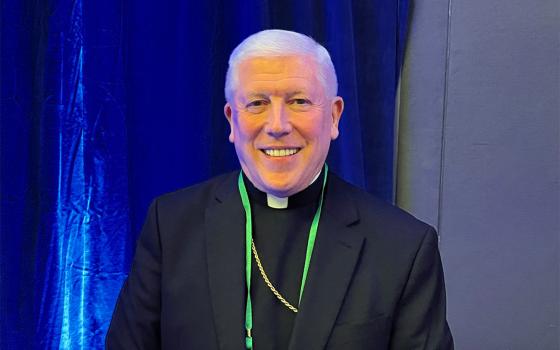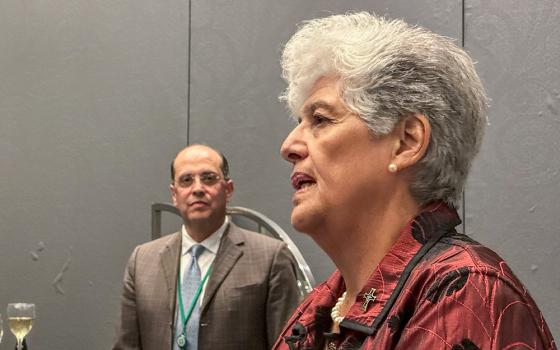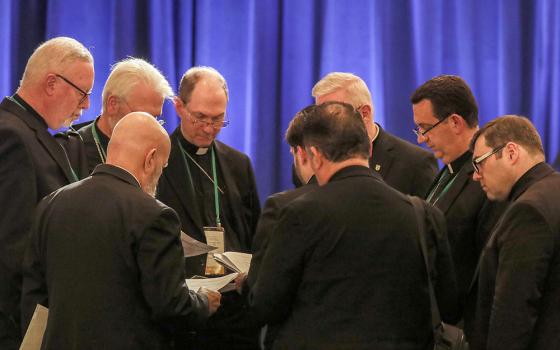Bishop Kevin C. Rhoades of Fort Wayne-South Bend, Ind., speaks during a conversation about the synod on synodality in Rome at a Nov. 14, 2023, session of the fall general assembly of the U.S. Conference of Catholic Bishops in Baltimore. Also pictured are Fr. Michael J.K. Fuller, USCCB general secretary; Archbishop Timothy Broglio of the U.S. Archdiocese for the Military Services, USCCB president; and Archbishop William Lori of Baltimore, USCCB vice president. (OSV News/Bob Roller)
The U.S. Catholic bishops will assemble in Baltimore for their plenary meeting the week after the election. Coming on the heels of both the global synod gathering in Rome and a highly contentious national election, the bishops need to address and overcome the divisions within their own ranks that emerged in the past year.
The internal divisions within the bishops' conference are worse than at any time in the three decades I have been attending the plenary meetings. Earlier this year, at their spring meeting in Louisville, the bishops debated the future of the Catholic Campaign for Human Development, the bishops' lead anti-poverty program.
The discussion was convened in secret, executive session but the president of the conference, Archbishop Timothy Broglio stated at the subsequent press conference that there had been broad support for CCHD's work. "In all the discussions, the bishops' ongoing commitment to the vital work of fighting poverty was clear,” said Broglio, archbishop for the military services, an archdiocese that serves Catholics serving in military installations in the U.S. and abroad.
What Broglio did not say, at the press conference, or during the executive session, according to sources familiar with what was discussed, was that he and the leadership of the conference planned to make severe staffing cuts not just on CCHD but on the entire Justice, Peace and Human Development office of which CCHD was a part. While the bishops discussed the issue, Broglio sat there, knowing the cuts were coming, and he said nothing.
"We were led to believe that it [CCHD] would continue to be a vibrant part of the conference," Hartford Archbishop Christopher Coyne told the National Catholic Reporter when the cuts were announced.
"At no point was any discussion made or talked about in terms of significant employee cuts," Conye said at the time. "It comes across as being somewhat duplicitous in terms of what was actually discussed with us as bishops and what actually happened."
Other leaders in the hierarchy voiced similar dismay.
If the bishops fail to unite, they will have nothing to say to the ambient, polarized culture. Unity must be their first objective.
Given this smoldering controversy, the first item for the bishops at their Nov. 11-14 plenary meeting is to restore trust amongst themselves. Bishops will want to know — and are entitled to know — why there was no discussion in advance of the personnel cuts. They want to know why one office absorbed the brunt of the staff reductions instead of asking each office of the conference secretariat to reduce staff.
The second task is how to keep two distinct initiatives going. July's National Eucharistic Congress ended with a stadium that wasn't sold out and calls nevertheless to hold another such congress. They spent an estimated $22 million for something that failed to live up to expectations. On the other hand, if it brought some people closer to the church and to the Lord, who am I to judge?
If they do mount another such National Eucharistic Congress, it would be nice to see some sound theology. Maybe they could find someone who could explain the difference between physical and sacramental presence?
The other initiative that needs to be furthered by the USCCB is synodality. In an interview with my colleague Christopher White, Chicago Cardinal Blase Cupich and San Diego Cardinal Robert McElroy called on the conference to become more synodal and to establish a standing committee that will help bishops embrace synodality. The synodal process must now be embraced at the local and continental levels if it is to make a meaningful change in the way the church discerns its mission.
The bishops will also vote on five committee chairs and a new treasurer. Look for Archbishop Bernard Hebda of St. Paul-Minneapolis to be elected treasurer of the conference. The center of the conference is just right of center, and Hebda fits the mold of a doctrinally conservative bishop but with a pastor's heart that characterizes many bishops who came from the ranks of the Pittsburgh clergy.
The Committee on Domestic Justice and Human Development chairmanship will be in good hands no matter who wins. Both Louisville Archbishop Shelton Fabre and Paterson Bishop Kevin Sweeney are fine men with keen minds, but I suspect Fabre is better known among his brother bishops for his deft handling of the Ad Hoc Committee Against Racism and will be chosen to lead the committee.
Look for Joliet Bishop Ronald Hicks to be selected to chair the Committee on Clergy, Consecrated Life and Vocations. He collaborated with Bishop Robert Barron when Barron was rector of the seminary at Mundelein and Hicks was in charge of formation, and later served as Cardinal Cupich's vicar general. Hicks is precisely the kind of bishop who can help unite the different wings of the conference.
I do not know anything about Cleveland Auxiliary Bishop Michael Woost, but I would vote for him to lead the Liturgy Committee. The alternative is Portland, Oregon, Archbishop Alexander Sample whose penchant for the Tridentine rite puts him at odds with the pope. His support for San Francisco Archbishop Salvatore Cordileone's decision to ban then House Speaker Nancy Pelosi from Communion shows his willingness to politicize — that is to say, desecrate — the Eucharist. He would be a disaster as committee chair.
Bishops pray June 13 at the U.S. Conference of Catholic Bishops' Spring Plenary Assembly in Louisville, Ky. (OSV News/Bob Roller)
The Committee on Migration is a tough choice. Bishop Joseph Tyson of Yakima, Washington, has done great work with migrant farm workers in his diocese, but he is ineffectual within the conference. Victoria Bishop Brendan Cahill has been working on the issue with his brother bishops in Texas for years, and I would expect him to win the election.
Bishop Edward Burns of Dallas is likely to take the contest for chair of the Committee on Laity, Marriage, Family Life and Youth. Another former Pittsburgh priest, Burns is conservative but not hyper-ideological; the other candidate, Lincoln Bishop James Conley, is a culture warrior of the first order. If the bishops are serious about coming together, they will choose Burns.
In recent meetings, the bishops have inched closer to the direction of the pope. Two years ago, the conference indicated hostility to the pope's agenda when Archbishop Paul Coakley defeated Cardinal Joseph Tobin in the election for secretary by a vote of 130-104. Last year, no contest had such a clear distinction between a papal ally and a papal detractor, but the vote totals were really close in races pitting a culture warrior against someone more pastoral. This year, the contests reflect more of a choice of unity within the conference versus a more strident culture war approach.
If the bishops fail to unite, they will have nothing to say to the ambient, polarized culture. Unity must be their first objective. It will require candor, synodality, and the selection of committee chairs who are good pastors, allergic to jeremiads and willing to forge consensus.
Advertisement







